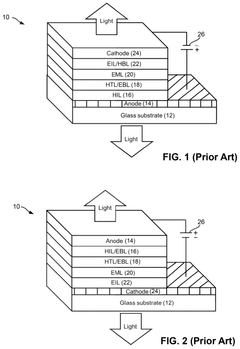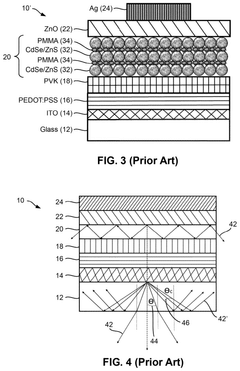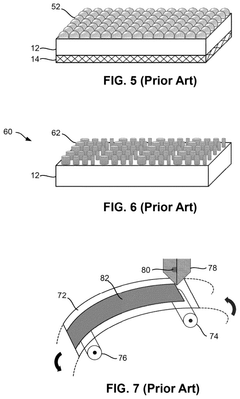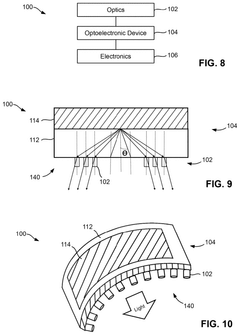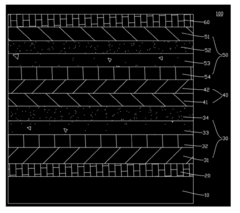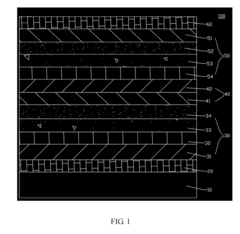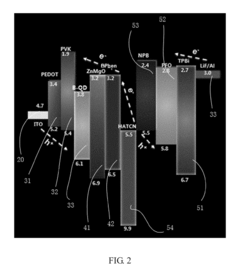QLED and Smart Devices: Creating Intelligent Ecosystems
JUN 20, 20258 MIN READ
Generate Your Research Report Instantly with AI Agent
Patsnap Eureka helps you evaluate technical feasibility & market potential.
QLED Tech Evolution
QLED technology has undergone significant evolution since its inception, transforming the landscape of display technology and smart devices. The journey began with the development of quantum dot light-emitting diodes (QLEDs), which offered superior color reproduction and energy efficiency compared to traditional LED displays.
In the early stages, QLED technology focused primarily on enhancing color gamut and brightness. Researchers worked on improving the quantum yield of quantum dots and developing more efficient blue LEDs as the excitation source. This led to QLED displays with wider color gamuts and higher peak brightness levels, surpassing the capabilities of OLED technology in certain aspects.
As QLED technology matured, the focus shifted towards improving contrast ratios and black levels. Manufacturers introduced local dimming techniques and mini-LED backlighting systems to address these challenges. These advancements resulted in QLED displays with deeper blacks and more precise control over brightness across the screen, narrowing the gap with OLED technology in terms of overall picture quality.
The integration of QLED technology with smart devices marked a significant milestone in its evolution. This convergence allowed for the creation of intelligent ecosystems where displays could interact seamlessly with other connected devices. QLED smart TVs became central hubs for home entertainment and automation, capable of controlling various IoT devices and offering personalized content recommendations.
Recent developments in QLED technology have focused on enhancing energy efficiency and reducing environmental impact. Researchers have explored new quantum dot materials and manufacturing processes to minimize the use of heavy metals and improve the overall sustainability of QLED displays.
The evolution of QLED technology has also seen advancements in form factor flexibility. Manufacturers have developed QLED displays that can be curved, bent, or even rolled, opening up new possibilities for innovative device designs and applications in various industries beyond consumer electronics.
As QLED technology continues to evolve, we are witnessing the emergence of micro-LED and nano-LED displays, which promise even higher pixel densities and more precise control over individual light-emitting elements. These advancements are paving the way for next-generation displays with unprecedented image quality and energy efficiency, further enhancing the capabilities of smart devices and intelligent ecosystems.
In the early stages, QLED technology focused primarily on enhancing color gamut and brightness. Researchers worked on improving the quantum yield of quantum dots and developing more efficient blue LEDs as the excitation source. This led to QLED displays with wider color gamuts and higher peak brightness levels, surpassing the capabilities of OLED technology in certain aspects.
As QLED technology matured, the focus shifted towards improving contrast ratios and black levels. Manufacturers introduced local dimming techniques and mini-LED backlighting systems to address these challenges. These advancements resulted in QLED displays with deeper blacks and more precise control over brightness across the screen, narrowing the gap with OLED technology in terms of overall picture quality.
The integration of QLED technology with smart devices marked a significant milestone in its evolution. This convergence allowed for the creation of intelligent ecosystems where displays could interact seamlessly with other connected devices. QLED smart TVs became central hubs for home entertainment and automation, capable of controlling various IoT devices and offering personalized content recommendations.
Recent developments in QLED technology have focused on enhancing energy efficiency and reducing environmental impact. Researchers have explored new quantum dot materials and manufacturing processes to minimize the use of heavy metals and improve the overall sustainability of QLED displays.
The evolution of QLED technology has also seen advancements in form factor flexibility. Manufacturers have developed QLED displays that can be curved, bent, or even rolled, opening up new possibilities for innovative device designs and applications in various industries beyond consumer electronics.
As QLED technology continues to evolve, we are witnessing the emergence of micro-LED and nano-LED displays, which promise even higher pixel densities and more precise control over individual light-emitting elements. These advancements are paving the way for next-generation displays with unprecedented image quality and energy efficiency, further enhancing the capabilities of smart devices and intelligent ecosystems.
Smart Device Market
The smart device market has experienced exponential growth in recent years, driven by advancements in technology and increasing consumer demand for connected, intelligent products. This market encompasses a wide range of devices, including smartphones, smart TVs, wearables, smart home appliances, and IoT-enabled gadgets. The integration of QLED technology with smart devices has further enhanced the market's potential, offering superior display quality and energy efficiency.
Global market trends indicate a steady increase in smart device adoption across various sectors. The consumer electronics segment remains the largest contributor, with smart TVs and smartphones leading the charge. However, emerging categories such as smart home devices and wearables are rapidly gaining traction. The industrial and healthcare sectors are also witnessing significant growth in smart device implementation, driven by the need for improved efficiency and remote monitoring capabilities.
The market is characterized by intense competition among major tech giants and innovative startups. Key players are continuously investing in research and development to introduce cutting-edge features and improve user experience. The integration of artificial intelligence and machine learning algorithms has become a crucial differentiator, enabling devices to offer personalized experiences and predictive functionalities.
Consumer behavior and preferences play a vital role in shaping the smart device market. There is a growing demand for seamless connectivity, interoperability between devices, and enhanced privacy features. Users are increasingly seeking devices that can integrate into their existing ecosystems, creating a cohesive and intelligent environment across their personal and professional lives.
Regional variations in market penetration and consumer preferences are notable. Developed markets such as North America and Western Europe show high adoption rates across various smart device categories. In contrast, emerging markets in Asia-Pacific and Latin America present significant growth opportunities, particularly in the smartphone and smart TV segments.
The COVID-19 pandemic has accelerated the adoption of smart devices, with remote work and digital entertainment driving demand for connected gadgets. This shift has also highlighted the importance of robust connectivity infrastructure and the need for devices that can support multiple functions in home environments.
Looking ahead, the smart device market is poised for continued growth, with several key trends shaping its future. The rollout of 5G networks is expected to revolutionize device capabilities, enabling faster data transfer and more responsive IoT applications. Additionally, the integration of advanced display technologies like QLED with smart functionalities is likely to create new product categories and enhance existing ones, further expanding the market's potential.
Global market trends indicate a steady increase in smart device adoption across various sectors. The consumer electronics segment remains the largest contributor, with smart TVs and smartphones leading the charge. However, emerging categories such as smart home devices and wearables are rapidly gaining traction. The industrial and healthcare sectors are also witnessing significant growth in smart device implementation, driven by the need for improved efficiency and remote monitoring capabilities.
The market is characterized by intense competition among major tech giants and innovative startups. Key players are continuously investing in research and development to introduce cutting-edge features and improve user experience. The integration of artificial intelligence and machine learning algorithms has become a crucial differentiator, enabling devices to offer personalized experiences and predictive functionalities.
Consumer behavior and preferences play a vital role in shaping the smart device market. There is a growing demand for seamless connectivity, interoperability between devices, and enhanced privacy features. Users are increasingly seeking devices that can integrate into their existing ecosystems, creating a cohesive and intelligent environment across their personal and professional lives.
Regional variations in market penetration and consumer preferences are notable. Developed markets such as North America and Western Europe show high adoption rates across various smart device categories. In contrast, emerging markets in Asia-Pacific and Latin America present significant growth opportunities, particularly in the smartphone and smart TV segments.
The COVID-19 pandemic has accelerated the adoption of smart devices, with remote work and digital entertainment driving demand for connected gadgets. This shift has also highlighted the importance of robust connectivity infrastructure and the need for devices that can support multiple functions in home environments.
Looking ahead, the smart device market is poised for continued growth, with several key trends shaping its future. The rollout of 5G networks is expected to revolutionize device capabilities, enabling faster data transfer and more responsive IoT applications. Additionally, the integration of advanced display technologies like QLED with smart functionalities is likely to create new product categories and enhance existing ones, further expanding the market's potential.
QLED Integration Challenges
The integration of QLED technology with smart devices presents several significant challenges that need to be addressed to create truly intelligent ecosystems. One of the primary obstacles is the complexity of merging QLED display technology with the diverse array of smart device functionalities. This integration requires seamless communication protocols and standardized interfaces to ensure smooth interaction between QLED displays and various smart devices.
Power management is another critical challenge in QLED integration. QLED displays typically consume more power than traditional LED or OLED displays, which can strain the battery life of portable smart devices. Developing energy-efficient QLED panels and implementing advanced power management systems are essential to overcome this hurdle and maintain the longevity of smart devices.
Heat dissipation is a significant concern when integrating QLED technology into compact smart devices. The high brightness and color performance of QLED displays can generate substantial heat, potentially affecting the overall performance and lifespan of the device. Innovative cooling solutions and thermal management techniques need to be developed to address this issue effectively.
The cost of QLED integration poses another challenge for widespread adoption in smart devices. While QLED technology offers superior display quality, it is currently more expensive than alternative display technologies. Reducing production costs and improving manufacturing processes are crucial to make QLED-integrated smart devices more accessible to consumers.
Durability and longevity of QLED displays in smart devices are also areas of concern. Smart devices are often subjected to various environmental conditions and physical stresses. Ensuring that QLED displays can withstand these challenges while maintaining their performance over time is essential for creating reliable intelligent ecosystems.
Software integration and optimization present another set of challenges. Developing operating systems and applications that can fully utilize the capabilities of QLED displays while ensuring compatibility with a wide range of smart devices requires significant effort. This includes optimizing user interfaces, color management, and content rendering to take full advantage of QLED's superior color gamut and contrast ratios.
Lastly, the challenge of seamless connectivity and interoperability between QLED-equipped smart devices and other components of the intelligent ecosystem cannot be overlooked. Establishing robust communication protocols and ensuring compatibility with various IoT platforms and smart home systems is crucial for creating a truly integrated and intelligent ecosystem centered around QLED technology.
Power management is another critical challenge in QLED integration. QLED displays typically consume more power than traditional LED or OLED displays, which can strain the battery life of portable smart devices. Developing energy-efficient QLED panels and implementing advanced power management systems are essential to overcome this hurdle and maintain the longevity of smart devices.
Heat dissipation is a significant concern when integrating QLED technology into compact smart devices. The high brightness and color performance of QLED displays can generate substantial heat, potentially affecting the overall performance and lifespan of the device. Innovative cooling solutions and thermal management techniques need to be developed to address this issue effectively.
The cost of QLED integration poses another challenge for widespread adoption in smart devices. While QLED technology offers superior display quality, it is currently more expensive than alternative display technologies. Reducing production costs and improving manufacturing processes are crucial to make QLED-integrated smart devices more accessible to consumers.
Durability and longevity of QLED displays in smart devices are also areas of concern. Smart devices are often subjected to various environmental conditions and physical stresses. Ensuring that QLED displays can withstand these challenges while maintaining their performance over time is essential for creating reliable intelligent ecosystems.
Software integration and optimization present another set of challenges. Developing operating systems and applications that can fully utilize the capabilities of QLED displays while ensuring compatibility with a wide range of smart devices requires significant effort. This includes optimizing user interfaces, color management, and content rendering to take full advantage of QLED's superior color gamut and contrast ratios.
Lastly, the challenge of seamless connectivity and interoperability between QLED-equipped smart devices and other components of the intelligent ecosystem cannot be overlooked. Establishing robust communication protocols and ensuring compatibility with various IoT platforms and smart home systems is crucial for creating a truly integrated and intelligent ecosystem centered around QLED technology.
Current QLED-Smart Solutions
01 QLED display technology advancements
Quantum Dot Light Emitting Diode (QLED) technology has seen significant improvements in display quality, color accuracy, and energy efficiency. These advancements have led to enhanced picture quality, wider color gamut, and better contrast ratios in smart devices, particularly in televisions and monitors.- QLED display technology advancements: Quantum Dot Light Emitting Diode (QLED) technology has seen significant improvements in display quality, color accuracy, and energy efficiency. These advancements have led to the development of smarter and more vibrant displays for various devices, including televisions, monitors, and mobile devices.
- Integration of AI and machine learning in smart devices: Smart devices are increasingly incorporating artificial intelligence and machine learning algorithms to enhance user experience, automate tasks, and provide personalized recommendations. This integration allows for more intuitive interactions and adaptive functionalities in various smart home and personal electronics applications.
- IoT connectivity and device interoperability: The Internet of Things (IoT) has enabled seamless connectivity between various smart devices, allowing for improved interoperability and data sharing. This connectivity enhances the overall functionality of smart ecosystems, enabling users to control and monitor multiple devices through centralized interfaces.
- Energy-efficient and sustainable smart device designs: Innovations in smart device design focus on improving energy efficiency and sustainability. This includes the development of low-power components, energy harvesting technologies, and the use of eco-friendly materials in device manufacturing, contributing to reduced environmental impact and extended battery life.
- Enhanced user interfaces and interaction methods: Smart devices are incorporating advanced user interfaces and interaction methods, such as gesture recognition, voice control, and haptic feedback. These innovations aim to make device interactions more natural, intuitive, and accessible to a wider range of users, including those with disabilities.
02 Smart device integration and connectivity
Innovations in smart device integration focus on seamless connectivity between QLED displays and other smart home devices. This includes improved IoT protocols, voice control systems, and multi-device synchronization, enhancing the overall user experience and creating more intelligent, interconnected ecosystems.Expand Specific Solutions03 AI-powered image processing and optimization
Artificial intelligence algorithms are being developed to enhance image processing capabilities in QLED displays. These AI systems can automatically adjust brightness, contrast, and color settings based on ambient lighting conditions and content type, resulting in optimized viewing experiences across various smart devices.Expand Specific Solutions04 Energy-efficient QLED technologies
Research is focused on developing more energy-efficient QLED technologies for smart devices. This includes improvements in quantum dot materials, backlight systems, and power management algorithms to reduce energy consumption while maintaining high display quality.Expand Specific Solutions05 Enhanced user interfaces for smart QLED devices
Innovations in user interface design for QLED-equipped smart devices aim to improve user interaction and accessibility. This includes development of gesture controls, eye-tracking technologies, and customizable interfaces that adapt to individual user preferences and usage patterns.Expand Specific Solutions
Key QLED-Smart Players
The QLED and smart device ecosystem is in a dynamic growth phase, with the market expanding rapidly as consumer demand for intelligent, interconnected devices increases. The technology's maturity is advancing, with key players like BOE Technology Group, Sharp Corp., and TCL China Star Optoelectronics leading innovation. These companies are driving progress in display technology, integrating QLED with smart functionalities. The competitive landscape is intense, with firms like Shenzhen China Star Optoelectronics and Guangzhou ChinaRay Optoelectronic Materials also making significant contributions. As the technology matures, we're seeing increased collaboration between display manufacturers, semiconductor companies, and software developers to create more sophisticated and seamlessly integrated smart ecosystems.
BOE Technology Group Co., Ltd.
Technical Solution: BOE has developed advanced QLED technology for smart devices, focusing on high color gamut, energy efficiency, and longevity. Their QLED panels incorporate quantum dot technology to enhance color accuracy and brightness. BOE's smart ecosystem integration allows seamless connectivity between QLED displays and various IoT devices, creating a unified user experience across multiple platforms. The company has also invested in AI-driven content optimization algorithms to automatically adjust display settings based on ambient conditions and user preferences.
Strengths: Strong R&D capabilities, vertical integration in display manufacturing, and extensive smart device ecosystem. Weaknesses: Intense competition in the high-end QLED market and potential supply chain vulnerabilities.
Sharp Corp.
Technical Solution: Sharp has developed a proprietary QLED technology called AQUOS QLED, which combines quantum dot technology with their advanced LCD panels. Their approach focuses on achieving superior color accuracy, high contrast ratios, and enhanced brightness levels. Sharp's smart ecosystem, AQUOS NET+, integrates QLED displays with various smart home devices, offering voice control, personalized content recommendations, and seamless device synchronization. The company has also implemented AI-powered upscaling technology to improve the viewing experience of lower resolution content on their QLED displays.
Strengths: Long-standing reputation in display technology, strong brand recognition, and established presence in the smart TV market. Weaknesses: Relatively smaller market share compared to some competitors and potential limitations in global distribution networks.
QLED-Smart Innovations
Integrated optoelectronic devices for lighting and display applications
PatentPendingUS20240341118A1
Innovation
- Incorporation of metasurfaces with two-dimensional arrays of nanostructures into the light-emitting devices to reduce photon reflection, control light direction, and manipulate emission profiles, combined with machine-learning methods for optimizing light patterns and using flexible substrates like hybrid silver nanowires and carbon nanotubes for improved conductivity and stability.
Series connected quantum dot light-emitting device, panel and display device
PatentActiveUS20180286927A1
Innovation
- A series connected quantum dot light-emitting device structure is introduced, comprising a first electrode, a first light-emitting unit with a quantum dot layer, a charge generation layer, and a second light-emitting unit with an organic layer, where the charge generation layer facilitates the series connection of both units, utilizing N-type and P-type layers formed by different materials to optimize electron and hole injection, thereby increasing luminous efficiency.
Interoperability Standards
Interoperability standards play a crucial role in creating intelligent ecosystems that seamlessly integrate QLED displays and smart devices. These standards ensure that different devices and systems can communicate and work together effectively, regardless of their manufacturer or specific technology.
One of the key interoperability standards in this domain is the HDMI (High-Definition Multimedia Interface) specification. HDMI 2.1, the latest version, supports higher resolutions, faster refresh rates, and enhanced audio capabilities, making it ideal for connecting QLED displays to various smart devices. It also includes features like Variable Refresh Rate (VRR) and Auto Low Latency Mode (ALLM), which are particularly beneficial for gaming and interactive applications.
Another important standard is Wi-Fi, which enables wireless connectivity between QLED displays and smart devices. The latest Wi-Fi 6 (802.11ax) standard offers improved speed, capacity, and efficiency, allowing for smoother streaming and faster data transfer between devices in the ecosystem.
Bluetooth technology, particularly Bluetooth Low Energy (BLE), is widely used for connecting peripherals and smart devices to QLED displays. It enables energy-efficient communication for devices like remote controls, smartphones, and wearables, enhancing the overall user experience within the ecosystem.
The Internet of Things (IoT) ecosystem relies heavily on interoperability standards such as MQTT (Message Queuing Telemetry Transport) and CoAP (Constrained Application Protocol). These lightweight protocols facilitate communication between QLED displays, smart devices, and cloud services, enabling features like voice control, content synchronization, and remote management.
For smart home integration, standards like Zigbee and Z-Wave provide low-power, mesh networking capabilities that allow QLED displays to interact with other smart home devices seamlessly. This enables scenarios where lighting, temperature, and other environmental factors can be automatically adjusted based on the content displayed on the QLED screen.
Voice assistant integration is another critical aspect of intelligent ecosystems. Standards like Google's Actions on Google and Amazon's Alexa Voice Service enable QLED displays to work with popular voice assistants, allowing users to control their displays and access content through voice commands.
As the ecosystem continues to evolve, emerging standards like Matter (formerly Project CHIP) aim to unify smart home devices across different platforms and manufacturers. This will further enhance the interoperability between QLED displays and a wide range of smart devices, creating more cohesive and user-friendly intelligent ecosystems.
One of the key interoperability standards in this domain is the HDMI (High-Definition Multimedia Interface) specification. HDMI 2.1, the latest version, supports higher resolutions, faster refresh rates, and enhanced audio capabilities, making it ideal for connecting QLED displays to various smart devices. It also includes features like Variable Refresh Rate (VRR) and Auto Low Latency Mode (ALLM), which are particularly beneficial for gaming and interactive applications.
Another important standard is Wi-Fi, which enables wireless connectivity between QLED displays and smart devices. The latest Wi-Fi 6 (802.11ax) standard offers improved speed, capacity, and efficiency, allowing for smoother streaming and faster data transfer between devices in the ecosystem.
Bluetooth technology, particularly Bluetooth Low Energy (BLE), is widely used for connecting peripherals and smart devices to QLED displays. It enables energy-efficient communication for devices like remote controls, smartphones, and wearables, enhancing the overall user experience within the ecosystem.
The Internet of Things (IoT) ecosystem relies heavily on interoperability standards such as MQTT (Message Queuing Telemetry Transport) and CoAP (Constrained Application Protocol). These lightweight protocols facilitate communication between QLED displays, smart devices, and cloud services, enabling features like voice control, content synchronization, and remote management.
For smart home integration, standards like Zigbee and Z-Wave provide low-power, mesh networking capabilities that allow QLED displays to interact with other smart home devices seamlessly. This enables scenarios where lighting, temperature, and other environmental factors can be automatically adjusted based on the content displayed on the QLED screen.
Voice assistant integration is another critical aspect of intelligent ecosystems. Standards like Google's Actions on Google and Amazon's Alexa Voice Service enable QLED displays to work with popular voice assistants, allowing users to control their displays and access content through voice commands.
As the ecosystem continues to evolve, emerging standards like Matter (formerly Project CHIP) aim to unify smart home devices across different platforms and manufacturers. This will further enhance the interoperability between QLED displays and a wide range of smart devices, creating more cohesive and user-friendly intelligent ecosystems.
Energy Efficiency Impact
The integration of QLED technology with smart devices has significant implications for energy efficiency in intelligent ecosystems. QLED displays, known for their superior brightness and color accuracy, have inherently lower power consumption compared to traditional LED and OLED technologies. This energy-efficient characteristic becomes particularly advantageous when incorporated into smart devices within an interconnected ecosystem.
In smart homes, QLED-equipped devices such as televisions, monitors, and digital signage can contribute to overall energy savings. These displays can automatically adjust their brightness and color temperature based on ambient light conditions, further reducing power consumption without compromising visual quality. When integrated with smart home systems, QLED devices can be programmed to enter low-power modes during periods of inactivity or when occupants are away, maximizing energy conservation.
The energy efficiency impact extends beyond individual devices to the entire smart ecosystem. QLED displays in smart hubs and control panels can provide vivid, always-on information displays while consuming minimal power. This enables users to monitor and manage their home's energy usage more effectively, potentially leading to additional energy savings across various connected appliances and systems.
In the context of smart cities, QLED technology in public displays and information kiosks can significantly reduce the energy footprint of urban infrastructure. These displays can deliver high-visibility information while operating at lower power levels, contributing to the overall energy efficiency goals of smart city initiatives.
The combination of QLED with IoT (Internet of Things) sensors and AI-driven analytics creates opportunities for even greater energy optimization. Smart devices equipped with QLED displays can visualize real-time energy consumption data, enabling users to make informed decisions about their energy usage patterns. AI algorithms can analyze this data to suggest energy-saving measures or automatically implement efficiency protocols across the ecosystem.
As QLED technology continues to evolve, we can expect further improvements in energy efficiency. Research is ongoing to enhance the quantum dot materials used in QLED, potentially leading to displays that require even less power to operate. This ongoing development aligns with the growing emphasis on sustainability in technology and the push for more energy-efficient smart ecosystems.
In smart homes, QLED-equipped devices such as televisions, monitors, and digital signage can contribute to overall energy savings. These displays can automatically adjust their brightness and color temperature based on ambient light conditions, further reducing power consumption without compromising visual quality. When integrated with smart home systems, QLED devices can be programmed to enter low-power modes during periods of inactivity or when occupants are away, maximizing energy conservation.
The energy efficiency impact extends beyond individual devices to the entire smart ecosystem. QLED displays in smart hubs and control panels can provide vivid, always-on information displays while consuming minimal power. This enables users to monitor and manage their home's energy usage more effectively, potentially leading to additional energy savings across various connected appliances and systems.
In the context of smart cities, QLED technology in public displays and information kiosks can significantly reduce the energy footprint of urban infrastructure. These displays can deliver high-visibility information while operating at lower power levels, contributing to the overall energy efficiency goals of smart city initiatives.
The combination of QLED with IoT (Internet of Things) sensors and AI-driven analytics creates opportunities for even greater energy optimization. Smart devices equipped with QLED displays can visualize real-time energy consumption data, enabling users to make informed decisions about their energy usage patterns. AI algorithms can analyze this data to suggest energy-saving measures or automatically implement efficiency protocols across the ecosystem.
As QLED technology continues to evolve, we can expect further improvements in energy efficiency. Research is ongoing to enhance the quantum dot materials used in QLED, potentially leading to displays that require even less power to operate. This ongoing development aligns with the growing emphasis on sustainability in technology and the push for more energy-efficient smart ecosystems.
Unlock deeper insights with Patsnap Eureka Quick Research — get a full tech report to explore trends and direct your research. Try now!
Generate Your Research Report Instantly with AI Agent
Supercharge your innovation with Patsnap Eureka AI Agent Platform!
